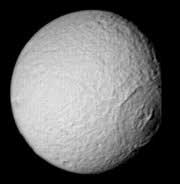
Odysseus is the huge, shallow crater on the right
Odysseus is the largest crater on Saturn's moon Tethys. It is 400 km in diameter, 2/5 of the moon's total size. It is named after the Greek hero Odysseus.
At the time of the Odysseus impact, Tethys must have been sufficiently warm and malleable to allow the topography to collapse. Tethys' interior may have even been liquid. If Tethys had been colder and more brittle at the time of impact, the moon may have been shattered. If it survived the impact, the topography of the crater would have retained its shape similar to Herschel Crater on Mimas.
The crater must have been deep with a high mountainous rim and towering central peak. Over time the crater floor relaxed to the spherical shape of the Tethys's surface, and the crater's rim and central peak collapsed. The crater no longer shows deep bowl shape characteristics of craters formed in cold ice or rock. (Similar relaxation is apparent on Jupiter's moons Callisto and Ganymede.)
Towards the upper-right limb is a portion of the immense trench Ithaca Chasma.
Retrieved from "http://en.wikipedia.org/"
All text is available under the terms of the GNU Free Documentation License

